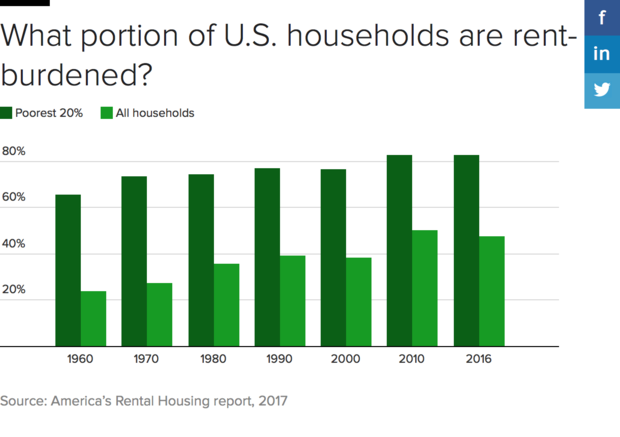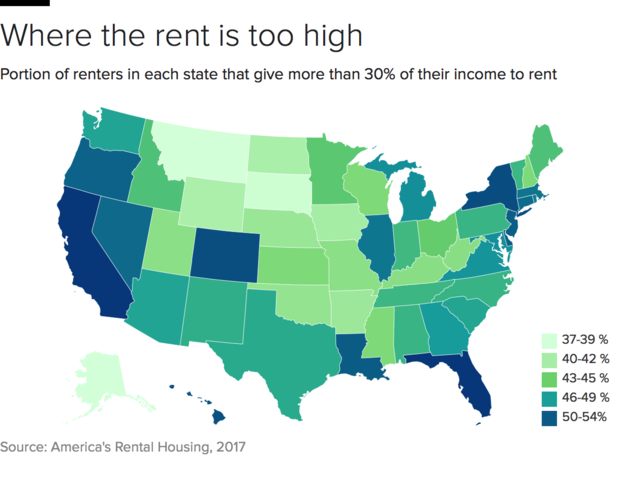Housing's "new normal": Struggling to pay the rent
Surging rents, a dearth of affordable housing, mounting competition for apartments from wealthier renters. Welcome to the American housing market's "new normal."
About half of renters across the US are "cost-burdened," meaning more than one-third of their income goes to their landlord, according to a recent study from Harvard University's Joint Center for Housing Studies.
And in a shift from previous era, it's not only lower-income households feeling the financial strain. Among Americans earning $45,000 to $75,000 a year, about 23 percent are cost-burdened -- that's nearly double the share in 2001, the study found.
As a result, many middle-class families are feeling the squeeze, especially in cities where they're priced out of the housing market. The U.S. homeless population is growing for the first time since the recession ended in 2010, a phenomenon that's especially acute in expensive cities such as San Francisco.
Ellen James-Penney, an English professor at San Jose State University, told CBS News housing costs eat up three-quarters of her monthly income. Her solution was to live in her car, she said.
Such troubling trends have their roots in the housing crisis a decade ago, when homeownership rates dropped and more families turned to the rental market. On top of that, older Americans find renting more appealing today than in prior decades, with the baby-boomer generation likely to boost the number of older renters through 2025, according to Harvard. Currently, about one-third of renters are older then 50 years old, on par with the share of renters under 35 years old.
While demand for home rentals has boomed, the rental supply hasn't kept up. About 74,000 new single-family rentals were created between 2015 to 2016, well below the 400,000 on average that were built per year between 2005 and 2015. And when new rental units come on the market, they're typically geared to higher-income renters, the study said.
"At the same time, the supply of moderate- and lower-cost units has increased only modestly," the report noted.
Another issue is the sharp divergence between incomes and rents. The typical U.S. family is still struggling to catch up to their income levels before the Great Recession. But rents have continued to climb, hitting household budgets.
"Between 2001 and 2011, median rental housing costs rose 5 percent in real terms while median renter incomes dropped 15 percent," the Harvard study noted.
High-income Americans are increasingly opting to rent, with the study finding that households with real annual incomes of more than $100,000 were responsible for 29 percent of the new 9.9 million renters who entered the market over the last decade. Many of those high-income renters live in pricey cities like New York and San Francisco.
Overall, the report noted, high housing costs are raising inequality among renters, with many poorer families struggling to pay for basic necessities after writing their monthly rent check.
"Turning back the tide on the nation's rental affordability challenges thus requires efforts to address lagging incomes among those near the bottom of the economic ladder as well as steps to help reduce the cost of housing," the report said. "And for those with low incomes, increasing access to rental assistance, expanding the low-cost stock and preserving affordable housing will be necessary to close the gap between income and housing costs."





